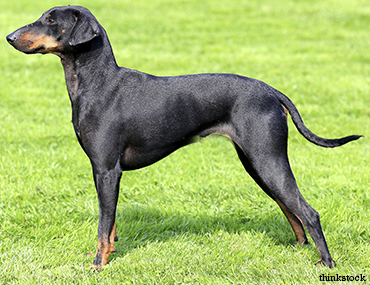Background
Originating in England, the Manchester Terrier made his debut in the 16th century. His progenitor was the oldest breed of terrier: the Black and Tan Terrier. The Manchester was bred to hunt rats and rabbits.
The American Kennel Club recognized the Manchester Terrier in 1887, following recognition of the Toy Manchester Terrier in 1886. It wasn’t until 1959 that the Manchester Terrier and the Toy Manchester Terrier were recognized as the same breed.
Sizing up
Weight: Toy -- up to 12 lbs. Standard -- 12 to 22 lbs.
Height: 15 to 16 inches
Coat: Short and glossy
Color: Black with tan markings
Life expectancy: 14 to 16 years
What’s the Manchester Terrier like?
The Manchester Terrier is playful, loving and loyal. His alert tendencies and bark make him a great watchdog. He likes to be active whether it’s on a nice stroll with you or chasing around small critters in your garden! When he’s not active you’ll find him curled up by your side. He may bark at strangers.
The Manchester Terrier can be overprotective, so the earlier you start training the better. He will form a strong bond quickly, and competent training will help you build up his trust even more. He can be a little stubborn and he does like to push buttons; therefore, you’ll need to be consistent and firm, but never harsh. Socializing is also highly important to keep him from snapping. Praise him when he’s done something correctly!
Grooming your Manchie is breeze! He needs only a quick brush--once a week--with a natural bristle brush.
Health
Health risks that might concern the Manchester Terrier include the following:
Glaucoma
Lens luxation
- A condition that occurs when the eye lens becomes dislocated
- A condition that clouds the lens of the eye and in some cases can lead to blindness. Because the Manchester Terrier is pure bred, he has a higher chance of developing cataracts than mixed breeds.
- A disease caused by an increase in metabolism
- A knee condition where one or both kneecaps slip out of place
Legg-Calve-Perthes Disease
- Mostly seen in Toy Manchies, LCPD is a bone disorder and is the result of decomposition of the hip joint caused by a spontaneous decaying of a part of the femur bone which is located in the dog’s hind leg.
- A hereditary condition caused by a lack of an adhesive glycoprotein in the blood that is needed to prevent blood clots.
Takeaway points
- The Manchester Terrier needs very little grooming.
- The Manchester Terrier is very adaptable and can live in the city or country.
- The Manchester Terrier is more suitable for a family with older children.
- The Manchester Terrier may not be the right breed for you if you work long hours.
